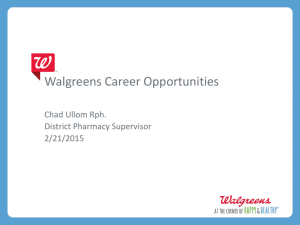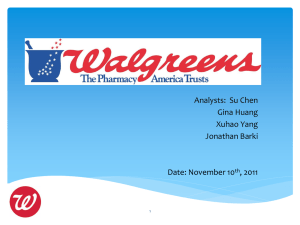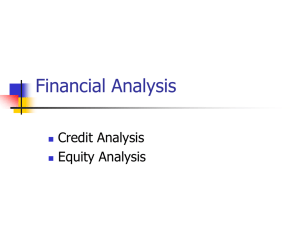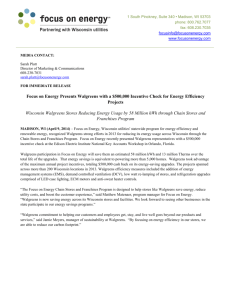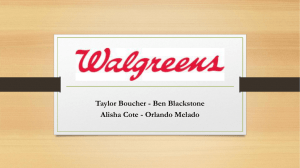Analysts
advertisement
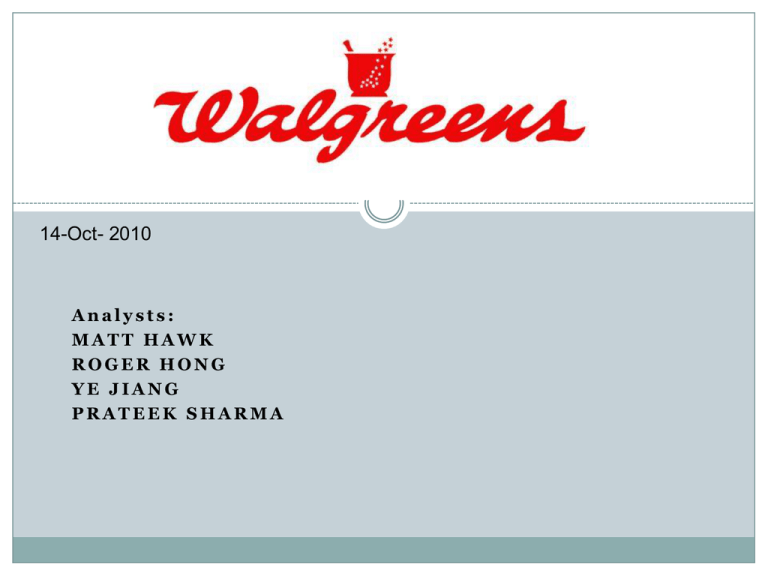
14-Oct- 2010 Analysts: MATT HAWK ROGER HONG YE JIANG PRATEEK SHARMA OUTLINE Company overview SWOT analysis Macro economy review Industry analysis/ Porter’s Five Forces Competitors DCF valuation Recommendation OUR HOLDINGS RCMP currently owns 500 shares of WAG Market Value (As of 13-Oct) WFR 7% WAG 15% AEO 37% Cost Basis AEO 20% WFR 25% BGC 7% MOS 12% DO 4% WAG 15% MCD 13% JKHY 9% DO 3% BGC 4% MOS 13% MCD 12% JKHY 4% WAG DETAIL RCMP purchased WAG 1,000 shares at $25/share on Oct. 06, 1999 RCMP sold WAG 500 shares at $49.94 Realized gain: $12,470 Currently owns 500 shares trading at $34.27 (as of Oct. 17, 2010) Unrealized gain: $4,635 HISTORY 1901 Charles R Walgreens Sr. purchased Chicago Drug Store where he had worked as a pharmacist -Start of Walgreens Chain 1926 1927 1975 Opened 100th Store Walgreens Co. Stock went Public Sales reached $1 Billion 1984 Opened 1000th store 1994 Opened 2000th store 2005 Opened 5000th store 2009 Opened 7000th store PRESENT • Walgreens is a retail drugstore chain that sells prescription and nonprescription drugs, and general merchandise – As of Aug. 31, 2010, Walgreens operated 8,046 locations in all 50 states, the District of Columbia, Puerto Rico and Guam. It employs around 238,000 people • Sales increased 7.4 percent to a record $16.9 billion for the fourth quarter and 6.4 percent to a record $67.4 billion for the fiscal 2010 • Walgreens filled a record 778 million prescriptions in fiscal 2010 an increase of 7.5 percent. Prescription sales: 65% RECENT EVENTS Sept 2010 – Walgreens and Omnicare reached an agreement in which Omnicare will acquire all of the assets of Walgreens long-term care pharmacy business, and in return Walgreens will acquire all of the assets of Omnicare’s home infusion businesses Aug 2010 – Walgreens announced an agreement with Graymark Healthcare Inc. (NASDAQ: GRMH) in which the company will acquire the assets of 18 ApothecaryRx pharmacies located in Colorado, Oklahoma, Minnesota, Missouri and Illinois April 2010 – Walgreens acquired Duane Reade Holdings, Inc for approx $1.1bn. The transaction included all 258 Duane Reade stores in the New York City metropolitan area, as well as Duane Reade’s corporate office and two distribution centers STOCK PERFORMANCE MANAGEMENT Key Executives Mr. Gregory D. Wasson President and CEO (Feb. 2009) Mr. Mark A. Wagner President-Community Management (Sept. 2010) Mr. Kermit R. Crawford President-Pharmacy Services (Sept. 2010) Mr. Wade D. Miquelon Executive Vice President-Chief Financial Officer (July 2009, joined from Tyson Food in 2008) GROWTH STRATEGY • Three Primary Components – Leveraging the best store network in America • – Enhancing customer Experience • • – Within five miles of nearly three-quarters of all Americans Customer Centric Retailing”(CCR): feature lower shelves and about 15 percent fewer individual items, which provides a more efficient and convenient shopping experience for today’s busy consumers. (Now more than 1,800 stores) Beer and wine was added to more than 3,500 stores and now is available in a total of nearly 4,200 stores Driving cost reduction and productivity gain • Rewiring for Growth: Target for $1 billion in annual savings in fiscal 2011 SWOT ANALYSIS Strengths Weakness Market Leadership (approx 30% mkt share) Consolidation of market – reduced independent drug stores Geographic Concentration - CA, FL, TX,IL, NY 40% Declining Operating Margin -5.13% in 2010 vs. 5.8% Avg. last 5 yrs Opportunity Threat Develop drive-thru model In-store clinics Aging Baby Boomers Patent expirations on generics in 2012/2013 From mass merchandisers ( they can afford lower margins) Mail-order businesses (offer greater convenience) Dependence on Medicare/Medicaid (reduction in rates could affect margins) MACROECONOMIC REVIEW Macro economy current: The tough economic conditions of 2008 and 2009 had a lasting effect on consumer behavior. Concern over high unemployment and declined consumer confidence affect customer’s spending habit. Price has become the single most important factor in making the purchase decision Consumer confidence: Unemployment Source:http://mjperry.blogspot.com/2010/06/consumer-confidence-highest-since-jan.html MACROECONOMIC REVIEW As the economy begins to strengthen in 2010 and 2011, decreasing unemployment and rising income levels should boost this industry’s pharmaceutical as well as front-end sales Also, as more consumers gain employment, the level of insurance coverage is expected to rise, thus increasing the likelihood people will purchase pills and other medicine Increase in health awareness among people will lead to increase in front-end sales of health related products Increased spending by the government on Medicare/Medicaid is expected to boost sales INDUSTRY ANALYSIS Industry Outlook: The industry outlook is positive: Sales will maintain growth due to an aging population, longer life expectancy and healthcare reform. Revenue is forecast to grow at an average annualized rate of 3.1% to total $251.9 billion in 2015 Highly Competitive Industry M&A: The industry will slow its new store openings after decades of rapid expansion, and consolidation will continue. Enterprise numbers will decline at an average annualized rate of 1.3% to settle at about 21,786 companies during the next five years Price: As Mass merchants, mail-order pharmacies and PBMs (pharmacy benefit managers ) continue to pose a threat to industry sales, they place downward pressure on prices Source:Pharmacies&Drug Stores in the US, ISBS World Industry Report 44611, July 2010 Medical reimbursement level Certain provisions of the Deficit Reduction Act of 2005 seek to reduce federal spending by altering the Medicaid reimbursement formula for generic drugs. These changes are expected to result in reduced Medicaid reimbursement rates for prescription Health reform Expand insurance coverage and subsequently increase pharmaceuticals’ demand as they become more affordable The government is expected to initiate cost cutting, which could adversely affect profit margins Source:https://materials.proxyvote.com/Approved/931422/20091116/AR_48630/HTML2/default.htm PORTER’S FIVE FORCES Barrier to Entry: Medium Consolidation that is creating large players with deep resources Government and state laws and regulations Threat of substitutes: Drugs: Low General Merchandise: High Few alternative choices, inelastic demand Supermarkets are large threats Bargaining power of buyers: Moderate Inelastic demand but thinning profit margin Bargaining power of suppliers: Moderate The large retailers purchase directly from several suppliers, strong relationship Rivalry among existing competitors: High Both internal and external sources, including other drug store chains or independent drug stores, supermarket chains, mass merchandisers, on-line retailers and mail order pharmacies COMPETITORS - DESCRIPTION CVS Caremark – CVS Caremark operates in two segments – Pharmacy Services and Retail Pharmacy. The Retail Pharmacy segment sells prescription drugs, over-the-counter drugs, beauty products and cosmetics, photo finishing, seasonal merchandise, greeting cards, and convenience foods through its pharmacy retail stores and online. It operates approx. 7,000 retail stores. For the year ending 31-Dec-2009, it reported sales of $98.729B Rite Aid Corporation – Rite Aid operates retail pharmacy stores . As of Feb 2010, it operated around 4,780 stores. It sells prescription drugs and an assortment of other merchandise. For the year ending Feb 2010, it reported a loss of $506.7M on revenues of $25.37B COMPARATIVE RATIOS CVS Caremark Company Walgreens Ticker WAG CVS RAD Current ROE Profit Margin 3.45% 3.76% -2.88% 3.1% Asset Turnover 2.62 1.61 3.2 2.62 Equity Multiplier 1.85 1.93 - 1.79 ROE (5-yr avg.) 16.71% 11.69% -256.66% 14.53% Source: Capital IQ Rite Aid Current ROA 8.13% SALES FORECAST We have optimistic growth expectations for WAG, expecting it to rebound from the economic turmoil it faced over the past two years ($ in millions) FY Ending 8/31 Sales Forcasted From Stores % Sales Growth Prescription Sales % sales % growth Non-prescription Sales % sales % growth General Merchandise % sales % growth Stores, beginning New openings Stores, ending % organic store growth % Same store sales 2010 2011 $67,420.0 $72,813.6 6.45% 8.00% 43,823.0 47,328.8 65.00% 65.00% 6.45% 8.00% 6,742.0 7,281.4 10.00% 10.00% 6.45% 8.00% 16,855.0 18,203.4 25.00% 25.00% 6.45% 8.00% 6,997 564 7,561 8.06% 1.98% 7,561 318 7879 4.20% 3.60% 2012 $79,148.4 8.70% 51,446.4 65.00% 8.70% 7,914.8 10.00% 8.70% 19,787.1 25.00% 8.70% 7879 362 8241 4.60% 4.50% FORECASTED 2013 $86,588.3 9.40% 57,148.3 66.00% 11.08% 8,658.8 10.00% 9.40% 21,647.1 25.00% 9.40% 8241 371 8612 4.50% 5.00% 2014 $92,736.1 7.10% 61,205.8 66.00% 7.10% 9,273.6 10.00% 7.10% 23,184.0 25.00% 7.10% 2015 $103,957.2 12.10% 68,611.7 66.00% 12.10% 10,395.7 10.00% 12.10% 25,989.3 25.00% 12.10% 2016 $114,352.9 10.00% 75,472.9 66.00% 10.00% 11,435.3 10.00% 10.00% 28,588.2 25.00% 10.00% 8612 344 8956 4.00% 5.20% 8956 336 9292 3.75% 5.50% 9292 325 9617 3.50% 5.60% GROWTH DRIVERS "Our use of cash has been, and will continue to be, guided by a capital policy that commits us to maintaining a strong balance sheet and financial flexibility; reinvesting in core strategies and related strategic activities; and returning surplus cash to shareholders in the form of dividends and share repurchases,“ - Greg Wasson GROWTH DRIVERS (Cont.) 1. Strong balance sheet and financial flexibility a) Allows WAG to return income to shareholders in the form of dividends and stock repurchases Slow store growth to free up capital and focus on WAG’s core business 3. 2009 Repurchase Program 4. “2008 Rewiring for Growth” Program 2. a) b) c) 5. Enhance the customer experience (CCR) Extend their presence in pharmacy, health and wellness services Cost reduction and productivity gain Reduce on-hand inventory a) Eliminate 3,500 products Source:http://news.walgreens.com/article_display.cfm?article_id=5260 RESULTS Sustain long-term revenue growth Increase margins through cost reduction (“Rewiring for Growth”) 2010 - $600 million cost reduction 2011 - $1000 million cost reduction ($400 million net gains) Double digit EPS growth 30-35% return to shareholders Low leverage allows WAG to compensate equity holders Source:http://news.walgreens.com/article_display.cfm?article_id=5260 ROE 2010 61.99% 97.54% 5.13% 256.59% 182.47% 14.52% Tax Burden Interest Burden Profit Margin Asset Turnover Leverage Ratio ROE 2011 63.47% 96.81% 4.97% 260.51% 173.20% 13.79% FORECASTED 2012 2013 63.47% 63.47% 97.55% 97.53% 5.96% 6.51% 258.25% 256.77% 172.50% 171.00% 16.43% 17.70% 2014 63.47% 97.69% 6.50% 252.00% 170.00% 17.27% 2015 63.47% 98.06% 6.90% 256.00% 169.50% 18.64% 2016 63.47% 98.36% 7.42% 254.41% 168.50% 19.86% 300.0% 254.4% 250.0% 200.0% 168.5% 150.0% 100.0% 98.4% 63.5% 50.0% 0.0% 2005 7.4% 2006 2007 Tax Burden 2008 2009 Interest Burden 2010 2011 Profit Margin 2012 2013 Asset Turnover 2014 2015 2016 Leverage Ratio DEBT SCHEDULE (WITHOUT OPERATING LEASES) ($ in millions) Cash Secured Debt Revolving Credit Facility Unsecured Debt 4.875% Senior Notes 5.250% Senior Notes Variable Loans Total Debt CAPITALIZATION SUMMARY Book Interest Value Rate Yield Debt / LTM EBITDA Estimated Interest Maturity Date $2,087.0 0.0 L + .525% 0.0 Nov-11 1,294.0 995.0 57.0 4.88% 5.25% NA 63.1 52.2 Aug-13 Jan-19 NA $2,346.0 Preferred Stock Shareholders' Equity Total Capitalization Debt/Capitalization 0.0 34,008.3 $36,354.3 6.45% Cash Revolver Availability Total Liquidity 2,087.0 1,200.0 $3,287.0 .6x $115.3 2009 CREDIT STATISTICS 2009 EBITDA Capital Expenditures 2009 EBITDA / Interest Expense (2009 EBITDA - Cap Ex) / Interest Expense 4,222.0 1,927.0 36.6x 19.9x DEBT SCHEDULE (WITH OPERATING LEASES) ($ in millions) Cash Secured Debt Revolving Credit Facility Unsecured Debt 4.875% Senior Notes 5.250% Senior Notes Variable Loans Operating Leases CAPITALIZATION SUMMARY Book Interest Value Rate Yield Debt / LTM EBITDA Estimated Interest Maturity Date $2,087.0 0.0 L + .525% 0.0 Nov-11 1,294.0 995.0 57.0 4.88% 5.25% NA 63.1 52.2 Aug-13 Jan-19 NA 2,024.0 NA 19,869.8 Total Debt $22,215.8 Preferred Stock Shareholders' Equity Total Capitalization Debt/Capitalization 0.0 34,008.3 $56,224.1 39.51% Cash Revolver Availability Total Liquidity 2,087.0 1,200.0 $3,287.0 5.3x $2,139.3 2009 CREDIT STATISTICS 2009 EBITDA Capital Expenditures 4,222.0 1,927.0 2009 EBITDA / Interest Expense (2009 EBITDA - Cap Ex) / Interest Expense Although WAG doesn’t have much long-term debt, its operating leases make it a much more highly levered company 2.x 1.1x WACC – W/ OPERATING LEASES Risk Free Rate (Rf) 2.46% Beta 0.82 Market Risk Premium 6.00% Cost of Equity (CAPM) 7.38% Cost of Debt 5.25% Tax Rate 36.53% Cost of Debt (Aftertax) 3.33% Weight of Equity 0.605 Wight of debt 0.395 WACC 8.63% COST OF EQUITY CAPM COMBINED ROE 7.38% 12.09% 16.79% Cost of Debt WACC Cost of Equity 3.33% 8.63% 12.09% Weight: 39.50% Weight: 60.50% DCF – W/ OPERATING LEASES DCF ANALYSIS (WITH OPERATING LEASES) ($ in millions) Forecasted FCF's: Terminal Value Discount Factor: Discount FCF's Shares Outstanding Share Price 8.63% 4% $40,359.1 22,215.8 18,143.3 977.25 $18.57 2 1,427.0 3 1,613.7 4 1,828.0 5 2,052.1 0.921 0.847 0.780 0.718 0.661 $1,974.2 $1,209.3 $1,258.9 $1,312.8 $1,356.8 6 2,326.7 52,296.9 0.609 $33,247.0 SENSITIVITY ANALYSIS (WITH OPERATING LEASES) TERMINAL GROWTH RATE Discount Rate Terminal Growth Rate Enterprise Value Net Debt Equity Value 1 2,144.6 $18.57 2.5% 3.0% 3.5% 4.0% 4.5% 5.0% 5.5% 7.5% 17.93 21.62 26.23 32.15 40.05 51.10 67.69 8.0% 14.13 17.07 20.67 25.18 30.96 38.68 49.48 8.5% 10.96 13.36 16.24 19.76 24.15 29.81 37.35 WACC 8.63% 10.24 12.52 15.25 18.57 22.69 27.95 34.88 9.0% 8.28 10.26 12.61 15.42 18.86 23.16 28.69 9.5% 5.99 7.65 9.59 11.88 14.63 17.99 22.19 10.0% 4.00 5.41 7.03 8.93 11.17 13.86 17.14 RELATIVE VALUATION Parameter Ratio Value P/E(ttm): 16.22 $34.41 Forward P/E 13.50 $28.89 P/S(ttm) 0.49 $32.36 P/B 2.31 $32.40 Price Range: $28-34 PERFORMANCE OVER TIME RECOMMENDATION Hold 500 shares at current price Any merger or acquisition in the industry could provide stimulus to stock price Regular dividend paying stock Consistently outperformed both S&P 500 and DJIA
